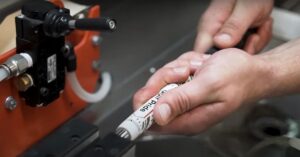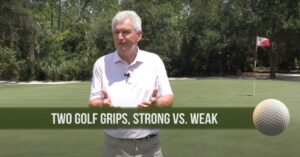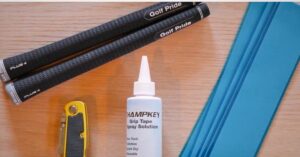Why Do Golfers Wear One Glove? The Significance Of A Single Glove
If you’ve ever watched a golf tournament, you’ve probably noticed that most golfers wear a glove on their left hand. But why do they only wear one glove? Can they wear two?
There are a few reasons why golfers wear one glove. One reason is that it helps to improve grip. The glove provides a layer of friction between the hand and the club, which can help to prevent the club from slipping.
In this article, we delve into the reasons behind this peculiar practice, exploring the history, advantages, and technique-related aspects that have made the golf glove an essential piece of equipment for golfers worldwide.
The Purpose Of Wearing A Golf Glove

A golf glove is an essential accessory for many golfers, serving multiple purposes on the course. It provides grip, enhances control, and protects the hands during the swing, ultimately improving overall performance.
Enhanced Grip and Control
One of the primary purposes of wearing a golf glove is to enhance grip and control of the golf club. The glove is typically made of leather or synthetic materials that offer a tacky texture, allowing the golfer to maintain a firm hold on the club.
The grip provided by the glove helps prevent the club from slipping during the swing, enabling more consistent and accurate shots.
Reduced Friction and Blister Prevention
Golf involves repetitive swinging motions, which can lead to friction and potential blisters on the hands. Wearing a golf glove helps reduce the friction between the hand and the grip of the club, minimizing the risk of developing painful blisters.
The glove acts as a barrier, preventing excessive rubbing and ensuring a smoother, more comfortable grip throughout the round.
Protection from Weather Conditions
Golf can be played in various weather conditions, including hot, humid, or rainy environments. A golf glove offers protection against these elements, keeping the hands dry and maintaining a consistent grip.
In hot and humid weather, the glove absorbs sweat, preventing it from affecting the grip. In wet conditions, the glove provides added traction, enhancing control even when the club and hands are damp.
Improved Swing Mechanics
Wearing a golf glove can also contribute to better swing mechanics. The glove helps maintain a consistent grip pressure, which is crucial for a smooth and controlled swing.
By providing a secure and comfortable connection between the hand and the club, the glove allows the golfer to focus on the swing technique, promoting a more fluid and efficient motion.
Style and Tradition
In addition to its functional benefits, the golf glove has become a symbol of style and tradition in the sport. Many golfers consider wearing a glove as part of the golfing attire, reflecting the rich heritage and etiquette of the game.
Golf gloves come in various designs and colors, allowing golfers to express their personal style while adhering to the traditions of the sport.
Common Concerns: Can Golfers Wear Two Gloves?

Golfers have the option to wear gloves on one or both hands while playing. While wearing two gloves is not a widely adopted practice, some golfers do choose to do so. Here are some points to consider:
Grip and Feel
Gloves provide golfers with a better grip on the club and enhance the feel during the swing. However, wearing two gloves might affect the tactile sensation and sensitivity, potentially impacting shot control.
Hand Preference
Golfers who wear two gloves typically wear them on both hands rather than doubling up on one hand. This approach allows for a more balanced grip and can be beneficial for those with sweaty hands or a preference for added stability.
Weather Conditions
The decision to wear two gloves may also depend on the weather conditions. In colder temperatures or rainy conditions, wearing two gloves can provide extra warmth and keep the hands dry, enhancing comfort and performance.
Personal Preference
Ultimately, the decision to wear one or two gloves is a matter of personal preference. Some golfers may feel more confident and comfortable with two gloves, while others prefer the traditional single glove or no gloves at all.
Etiquette and Style
While there are no specific rules prohibiting the use of two gloves, it’s worth noting that wearing two gloves is not as common in golf. Traditional golf etiquette leans towards a single glove, and some golfers may view wearing two gloves as unconventional or unnecessary.
Grip Enhancement: How A Golf Glove Improves Performance

A golf glove is an essential accessory that not only provides comfort but also improves performance on the golf course. Its grip-enhancing features play a crucial role in enhancing a golfer’s swing, control, and overall game.
Enhanced Grip for Better Control
A golf glove is designed with specialized materials, such as leather or synthetic materials, that offer excellent grip on the club handle. The texture and construction of the glove provide friction between the hand and the club, ensuring a secure grip.
This enhanced grip enables golfers to have better control over the club, leading to more accurate shots and improved performance.
Increased Stability and Reduced Slippage
During a golf swing, a firm grip on the club is vital to maintain stability and prevent slippage. A golf glove provides additional stability by minimizing unwanted movement between the hand and the club handle.
The snug fit of the glove helps eliminate potential slipping, allowing golfers to swing with confidence and maintain consistency in their shots.
Absorption of Sweat and Moisture
Golfers often face the challenge of sweaty hands, particularly in warm weather or during intense gameplay. A golf glove helps address this issue by absorbing sweat and moisture from the hand, ensuring a dry and comfortable grip.
By keeping the hand dry, the glove prevents the club from slipping due to moisture, thus improving grip and overall performance.
Protection and Comfort
In addition to enhancing grip, a golf glove offers protection and comfort to the golfer’s hand. The glove acts as a barrier between the hand and the club, reducing the risk of blisters, calluses, or friction-related injuries.
Moreover, the cushioning and padding in the glove provide a comfortable feel, allowing golfers to maintain focus and play for extended periods without discomfort.
Improved Feel and Sensitivity
Contrary to popular belief, a golf glove does not diminish the golfer’s feel or sensitivity. In fact, a well-fitted glove enhances these aspects by providing a consistent connection between the hand and the club.
This improved feel allows golfers to better sense the club’s position and make precise adjustments during the swing, leading to improved accuracy and performance.
Preventing Blisters And Calluses: The Role Of The Golf Glove
Maintaining a firm grip on the club is essential for achieving accurate shots when it comes to golfing. However, this repetitive action can lead to hand blisters and calluses.
This is where a golf glove plays a crucial role in preventing such discomfort and improving overall performance on the course.
Protecting the Hands
A golf glove serves as a protective barrier between the hands and the golf club, reducing friction and minimizing the chances of blisters and calluses.
The glove is typically made of leather or synthetic materials that offer durability and flexibility while allowing for a comfortable grip.
Enhancing Grip
One of the primary functions of a golf glove is to enhance grip strength. Sweaty palms can make it challenging to maintain a secure hold on the club, leading to slippage and potential injuries.
The glove’s material and specialized texture or grip patterns on the palm and fingers provide better traction and stability during the swing.
Absorbing Moisture
During a round of golf, perspiration can accumulate on the hands, making them slippery and prone to blisters. A golf glove acts as a moisture-absorbing layer, wicking away sweat and keeping the hands dry.
This moisture management feature further contributes to maintaining a consistent grip and preventing discomfort.
Promoting Consistency
Wearing a golf glove creates a consistent feel between the hands and the club. The texture and fit of the glove help golfers develop muscle memory and a repeatable swing.
This consistency can lead to improved control, accuracy, and distance in shots, as well as reducing the likelihood of developing blisters or calluses due to inconsistencies in grip.
Improving Overall Comfort
A well-fitted golf glove offers additional padding and support to the hands, reducing the impact and vibrations that can occur during swings.
This added comfort allows golfers to focus on their game without distractions or discomfort caused by excessive friction or pressure on certain areas of the hand.
Maintaining Feel And Sensitivity: Choosing The Right Glove
When it comes to selecting the perfect glove, it’s crucial to consider factors that preserve your sense of touch and sensitivity. Here are some essential guidelines to help you choose the ideal glove for your needs.
Determine Your Purpose
Before diving into the myriad of glove options available, identify the specific purpose for which you require them. Consider whether you need gloves for sports, industrial work, gardening, or general use, as each activity may have unique requirements.
Assess the Fit
Proper fit is paramount for maintaining feel and sensitivity. Gloves that are too loose may hinder dexterity, while tight-fitting gloves can restrict movement and cause discomfort. Look for gloves with adjustable closures or sizing options to ensure a snug but comfortable fit.
Material Matters
Selecting the right material is crucial for maintaining sensitivity. Depending on your purpose, consider different materials such as leather, synthetic fabrics, or specialized blends.
Each material offers distinct advantages, so weigh factors like durability, breathability, and grip when making your decision.
Thickness and Dexterity
Strike a balance between thickness and dexterity to maintain optimal sensitivity. Thicker gloves might offer better protection, but they can compromise your ability to perform intricate tasks.
Look for gloves that provide adequate protection without sacrificing your ability to feel and manipulate objects.
Grip and Tactility
For activities that require a firm grip, choose gloves with textured or coated palms and fingers. This enhances your ability to hold onto objects securely without compromising sensitivity.
Tactile gloves are designed to maintain a high level of sensitivity, making them ideal for tasks that require fine motor skills.
Consider Specialized Features
Certain activities may benefit from specialized glove features. For example, touchscreen-compatible gloves allow you to use smartphones or tablets without removing your gloves, making them ideal for outdoor activities or jobs that involve electronic devices.
Additionally, gloves with reinforced fingertips or knuckle protection can be beneficial for tasks that involve impact or abrasion.
Try Before You Buy
Whenever possible, try on gloves before making a purchase. This allows you to assess the fit, comfort, and feel firsthand. If trying on isn’t an option, carefully review sizing charts and customer reviews to ensure you select the right size and style for your needs.
Frequently Asked Questions
Golfers often wear one glove to enhance their grip and control over the golf club. This single glove, typically worn on the non-dominant hand, offers several benefits that improve a golfer’s swing and overall performance.
Why Do Golfers Wear One Glove?
Wearing one glove provides golfers with a better grip on the club, especially during hot and humid conditions when hands can become sweaty. It prevents the club from slipping, ensuring a more stable and controlled swing.
Which Hand Do Golfers Wear The Glove On?
Golfers typically wear the glove on their non-dominant hand. For right-handed golfers, this means wearing the glove on the left hand, while left-handed golfers wear it on their right hand. The dominant hand remains bare to maintain maximum feel and touch on the club.
Can Golfers Wear Gloves On Both Hands?
Although it’s uncommon, some golfers may choose to wear gloves on both hands. This is often a personal preference and can provide additional grip and stability. However, wearing gloves on both hands may decrease sensitivity and feel, so it’s not the norm.
Do All Golfers Wear Gloves?
Not all golfers wear gloves. It largely depends on individual preference and playing style. Some golfers may find that they have a strong enough grip without a glove, or they may prefer the direct contact between their hand and the club.
Do Professional Golfers Wear Gloves?
Many professional golfers choose to wear gloves during their rounds. The added grip and control they provide can be especially crucial in high-pressure situations.
However, just like amateur golfers, the decision to wear a glove is based on personal preference, and not all professional golfers opt to use one.
Conclusion
Golfers wear one glove primarily to enhance their grip on the club, improve control, prevent slippage, and protect their hands.
The glove provides a layer of friction, absorbs moisture, and promotes consistency in the swing. While wearing two gloves is less common, it can offer added stability and comfort in certain weather conditions.
Ultimately, the decision to wear one or two gloves is a matter of personal preference and individual needs.






